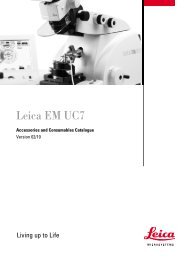Physical Principles of Electron Microscopy: An Introduction to TEM ...
Physical Principles of Electron Microscopy: An Introduction to TEM ...
Physical Principles of Electron Microscopy: An Introduction to TEM ...
Create successful ePaper yourself
Turn your PDF publications into a flip-book with our unique Google optimized e-Paper software.
<strong>Electron</strong> Optics 51<br />
From Eq. (2.7), the focal length <strong>of</strong> the lens can be written as f = AE0 where<br />
A is independent <strong>of</strong> electron energy, and taking derivatives gives: �f = A �E0<br />
= (f/E0) �E0 . The loss <strong>of</strong> spatial resolution due <strong>to</strong> chromatic aberration is<br />
therefore:<br />
rc � �f (�E0/E0) (2.20)<br />
More generally, a coefficient <strong>of</strong> chromatic aberration Cc is defined by the<br />
equation:<br />
rc � �Cc (�E0 /E0) (2.21)<br />
Our analysis has shown that Cc = f in the thin-lens approximation. A more<br />
exact (thick-lens) treatment gives Cc slightly smaller than f for a weak lens<br />
and typically f/2 for a strong lens; see Fig. 2-13. As in the case <strong>of</strong> spherical<br />
aberration, chromatic aberration cannot be eliminated through lens design<br />
but is minimized by making the lens as strong as possible (large focusing<br />
power, small f ) and by using an angle-limiting aperture (restricting �). High<br />
electron-accelerating voltage (large E0) also reduces the chromatic effect.<br />
Axial astigmatism<br />
So far we have assumed complete axial symmetry <strong>of</strong> the magnetic field that<br />
focuses the electrons. In practice, lens polepieces cannot be machined with<br />
perfect accuracy, and the polepiece material may be slightly inhomogeneous,<br />
resulting in local variations in relative permeability. In either case, the<br />
departure from cylindrical symmetry will cause the magnetic field at a given<br />
radius r from the z-axis <strong>to</strong> depend on the plane <strong>of</strong> incidence <strong>of</strong> an incoming<br />
electron (i.e., on its azimuthal angle �, viewed along the z-axis). According<br />
<strong>to</strong> Eq. (2.9), this difference in magnetic field will give rise <strong>to</strong> a difference in<br />
focusing<br />
power, and the lens is said <strong>to</strong> suffer from axial astigmatism.<br />
Figure 2.15a shows electrons leaving an on-axis object point P at equal<br />
angles <strong>to</strong> the z-axis but traveling in the x-z and y-z planes. They cross the<br />
optic axis at different points, Fx and Fy , displaced along the z-axis. In the<br />
case <strong>of</strong> Fig. 2-15a, the x-axis corresponds <strong>to</strong> the lowest focusing power and<br />
the perpendicular y-direction corresponds <strong>to</strong> the highest focusing power.<br />
In practice, electrons leave P with all azimuthal angles and at all angles<br />
(up <strong>to</strong> �) relative <strong>to</strong> the z-axis. At the plane containing Fy , the electrons lie<br />
within a caustic figure that approximates <strong>to</strong> an ellipse whose long axis lies<br />
parallel <strong>to</strong> the x-direction. At Fx they lie within an ellipse whose long axis<br />
points in the y-direction. At some intermediate plane F, the electrons define a<br />
circular disk <strong>of</strong> confusion <strong>of</strong> radius R, rather than a single point. If that plane<br />
is used as the image (magnification M), astigmatism will limit the point<br />
resolution <strong>to</strong> a value R/M.



